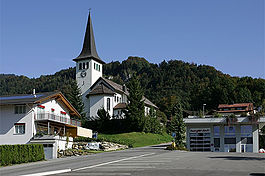|
Illgau
Illgau is a municipality in Schwyz District in the canton of Schwyz in Switzerland. HistoryIllgau is first mentioned in 1370 as Ilgoe.[3] Geography  Illgau has an area, as of 2006[update], of 10.9 km2 (4.2 sq mi). Of this area, 62% is used for agricultural purposes, while 31.1% is forested. Of the rest of the land, 2.9% is settled (buildings or roads) and the remainder (4%) is non-productive (rivers, glaciers or mountains).[4] It consists of the village sections of Illgau, Vorder Oberberg and Hinter Oberberg as well as scattered farm houses. All of the farm houses, up to about the 1,300 m (4,300 ft) level are occupied throughout the year. DemographicsIllgau has a population (as of 31 December 2020) of 795.[5] As of 2007[update], 1.6% of the population was made up of foreign nationals.[6] Over the last 10 years the population has grown at a rate of 7%. Most of the population (as of 2000[update]) speaks German (99.2%), with Albanian being second most common ( 0.3%) and Russian being third ( 0.3%).[4] As of 2000[update] the gender distribution of the population was 50.8% male and 49.2% female. The age distribution, as of 2008[update], in Illgau is; 242 people or 33.6% of the population is between 0 and 19. 241 people or 33.4% are 20 to 39, and 166 people or 23.0% are 40 to 64. The senior population distribution is 45 people or 6.2% are 65 to 74. There are 19 people or 2.6% who are 70 to 79 and 8 people or 1.11% of the population who are over 80.[6]  As of 2000[update] there are 248 households, of which 71 households (or about 28.6%) contain only a single individual. 31 or about 12.5% are large households, with at least five members.[6] In the 2007 election the most popular party was the SVP which received 53.9% of the vote. The next three most popular parties were the CVP (36.4%), the SPS (5.5%) and the FDP (1.7%).[4] The entire Swiss population is generally well educated. In Illgau about 55.2% of the population (between age 25-64) have completed either non-mandatory upper secondary education or additional higher education (either university or a Fachhochschule).[4] Illgau has an unemployment rate of 0.96%. As of 2005[update], there were 70 people employed in the primary economic sector and about 28 businesses involved in this sector. 63 people are employed in the secondary sector and there are 8 businesses in this sector. 71 people are employed in the tertiary sector, with 14 businesses in this sector.[4] From the 2000 census[update], 698 or 96.8% are Roman Catholic, while less than 5 people belonged to the Swiss Reformed Church. There are 6 (or about 0.83% of the population) who are Islamic. 9 (or about 1.25% of the population) belong to no church, are agnostic or atheist, and 6 individuals (or about 0.83% of the population) did not answer the question.[6] The historical population is given in the following table:[3]
References
Wikimedia Commons has media related to Illgau. External links
|
||||||||||||||||||||||||||||||||||||||||||||||||||||||||||||||
Portal di Ensiklopedia Dunia




